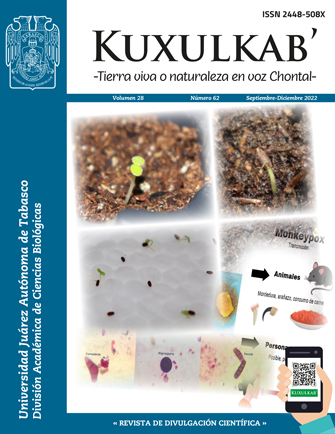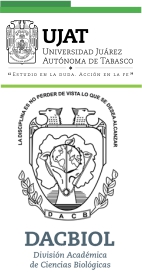THE PRESENCE OF PLASTICS IN MARINE MAMMALS
COMMON TYPE MICROPLASTICS AND THEIR FEATURES
DOI:
https://doi.org/10.19136/kuxulkab.a28n62.5277Keywords:
Microplastics, Marine mammals, Gastrointestinal tract, Scats, FibersAbstract
The presence of microplastics in the aquatic environment encourages fauna to acquire these materials directly or indirectly through food, mainly. Marine mammals are no exception and due to their large size, they are susceptible to acquiring microplastics. This study seeks to define what type of polymers are present in aquatic mammals and what body distribution they have based on their properties, such as color, morphology, size, and type of polymer reported in the last four years and seven months. It was observed that compounds such as polypropylene, polyethylene terephthalate, and polyethylene are present in most marine mammals. The dominant colors of these microplastics become black, blue, colorless, green, and gray, among others. Based on morphology, fibers and fragments dominate in a size range that varies between 100-20,000 µm for fibers and 44-40,000 µm for fragments, respectively.
Downloads
References
Alexiadou, P.; Foskolos, I. & Frantzis, A. (2019). Ingestion of macroplastics by odontocetes of the Greek Seas, Eastern Mediterranean: Often deadly!. Marine Pollution Bulletin, 146: 67–75. https://doi.org/10.1016/J.MARPOLBUL.2019.05.055
Ayala, F.; Cardeña, M. & Cárdenas-Alayza, S. (2021). Registro preliminar de microplásticos en fecas del león marino sudamericano (“Otaria byronia” [de Blainville 1820]) recolectadas en punta San Juan, Perú. Revista Internacional de Contaminación Ambiental, 37: 273–279. https://doi.org/10.20937/RICA.53745
Banerjee, A. & Shelver, W.L. (2021). Micro- and nanoplastic induced cellular toxicity in mammals: A review. The Science of the Total Environment, 755(Pt 2). https://doi.org/10.1016/j.scitotenv.2020.142518
Battaglia, F.M.; Beckingham, B.A.; & McFee, W.E. (2020). First report from North America of microplastics in the gastrointestinal tract of stranded bottlenose dolphins (“Tursiops truncatus”). Marine Pollution Bulletin, 160: 111677. https://doi.org/10.1016/j.marpolbul.2020.111677
Besseling, E.; Foekema, E.M.; Van Franeker, J.A.; Leopold, M.F.; Kühn, S.; Bravo Rebolledo, E.L.; Heße, E.; Mielke, L.; IJzer, J.; Kamminga, P. & Koelmans, A.A. (2015). Microplastic in a macro filter feeder: Humpback whale “Megaptera novaeangliae”. Marine Pollution Bulletin, 95(1): 248–252. https://doi.org/10.1016/j.marpolbul.2015.04.007
Bradney, L.; Wijesekara, H.; Palansooriya, K.N.; Obadamudalige, N.; Bolan, N.S.; Ok, Y.S.; Rinklebe, J.; Kim, K.H. & Kirkham, M.B. (2019). Particulate plastics as a vector for toxic trace-element uptake by aquatic and terrestrial organisms and human health risk. Environment International, 131: 18. https://doi.org/10.1016/J.ENVINT.2019.104937
Brydson, J. (1999). Plastics Materials. In: Analysis and Deformulation of Polymeric Materials (Seventh ed). Springer. https://doi.org/10.1007/0-306-46908-1_8
Butterworth, A. & Sayer, S. (2017). The Welfare Impact on Pinnipeds of Marine Debris and Fisheries. Marine Mammal Welfare, 17: 215–239. https://doi.org/10.1007/978-3-319-46994-2_13
Carbery, M.; O’Connor, W. & Palanisami, T. (2018). Trophic transfer of microplastics and mixed contaminants in the marine food web and implications for human health. Environment International, 115: 400–409. https://doi.org/10.1016/J.ENVINT.2018.03.007
Castañeta, G.; Gutiérrez, A.F.; Nacaratte, F. & Manzano, C.A. (2020). Microplásticos: un contaminante que crece en todas las esferas ambientales, riesgos para la salud pública por exposición. Revista Boliviana de Química, 37(3): 160–175. https://doi.org/10.34098/2078-3949.37.3.4
Courtene-Jones, W.; Quinn, B.; Gary, S.F.; Mogg, A.O.M. & Narayanaswamy, B.E. (2017). Microplastic pollution identified in deep-sea water and ingested by benthic invertebrates in the Rockall Trough, North Atlantic Ocean. Environmental Pollution, 231: 271–280. https://doi.org/10.1016/j.envpol.2017.08.026
D’Agostino, F.; Bellante, A.; Quinci, E.; Gherardi, S.; Placenti, F.; Sabatino, N.; Buffa, G.; Avellone, G.; Di Stefano, V. & Del Core, M. (2020). Persistent and Emerging Organic Pollutants in the Marine Coastal Environment of the Gulf of Milazzo (Southern Italy): Human Health Risk Assessment. Frontiers in Environmental Science, 8: 117. https://doi.org/10.3389/FENVS.2020.00117/BIBTEX
Donohue, M.J.; Masura, J.; Gelatt, T.; Ream, R.; Baker, J.D., Faulhaber, K. & Lerner, D.T. (2019). Evaluating exposure of northern fur seals, “Callorhinus ursinus”, to microplastic pollution through fecal analysis. Marine Pollution Bulletin, 138: 213–221. https://doi.org/10.1016/j.marpolbul.2018.11.036
Dool, T. & Bosker, T. (2022). Predicted microplastic uptake through trophic transfer by the short-beaked common dolphin (“Delphinus delphis”) and common bottlenose dolphin (“Tursiops truncatus”) in the Northeast Atlantic Ocean and Mediterranean Sea. Marine Pollution Bulletin, 180: 113745. https://doi.org/10.1016/j.marpolbul.2022.113745
Dudek, K.L.; Cruz, B.N.; Polidoro, B. & Neuer, S. (2020). Microbial colonization of microplastics in the Caribbean Sea. Limnology and Oceanography Letters, 5(1): 5–17. https://doi.org/10.1002/LOL2.10141
Eriksson, C. & Burton, H. (2003). Origins and biological accumulation of small plastic particles in fur seals from Macquarie Island. Ambio, 32(6): 380–384. https://doi.org/10.1579/0044-7447-32.6.380
Erni-Cassola, G.; Zadjelovic, V.; Gibson, M.I. & Christie-Oleza, J.A. (2019). Distribution of plastic polymer types in the marine environment; A meta-analysis. Journal of Hazardous Materials, 369: 691–698. https://doi.org/10.1016/j.jhazmat.2019.02.067
Fossi, M.C.; Coppola, D.; Baini, M.; Giannetti, M.; Guerranti, C.; Marsili, L.; Panti, C.; de Sabata, E. & Clò, S. (2014). Large filter feeding marine organisms as indicators of microplastic in the pelagic environment: The case studies of the Mediterranean basking shark (“Cetorhinus maximus”) and fin whale (“Balaenoptera physalus”). Marine Environmental Research, 100: 1–8. https://doi.org/10.1016/j.marenvres.2014.02.002
Friot, D. & Boucher, J. (2017). Primary microplastics in the oceans | IUCN Library System (C.G. Lundin, J.M. de Sousa & Francis (eds.)). IUCN, Gland, Switzerland. https://doi.org/dx.doi.org/10.2305/IUCN.CH.2017.01.en Julien
Galloway, T.S. & Lewis, C.N. (2016). Marine microplastics spell big problems for future generations. Proceedings of the National Academy of Sciences of the United States of America, 113(9): 2331–2333. https://doi.org/10.1073/pnas.1600715113
Galloway, T.S.; Cole, M. & Lewis, C. (2017). Interactions of microplastic debris throughout the marine ecosystem. Nature Ecology & Evolution, 1(5): 1–8. https://doi.org/10.1038/s41559-017-0116
García Piqueras, M. & Torres Gavilá, J. (2021). Clínica y sanidad de odontocetos y pinnípedos en cautividad y vida libre. Nereis, 13. 187–202. https://doi.org/10.46583/NEREIS_2021.13
Gobierno de los Estados Unidos Mexicanos. (2010). Norma Oficial Mexicana NOM-059-SEMARNAT-2010, Protección ambiental-Especies nativas de México de flora y fauna silvestres-Categorías de riesgo y especificaciones para su inclusión, exclusión o cambio-Lista de especies en riesgo (p. 78). Diario Oficial de la Federación − Secretaria de Gobernación; Secretaría de Medio Ambiente y Recursos Naturales (SEMARNAT). https://www.dof.gob.mx/normasOficiales/4254/semarnat/semarnat.htm
Hale, R.C.; Seeley, M.E.; La Guardia, M.J.; Mai, L. & Zeng, E.Y. (2020). A global perspective on microplastics. Journal of Geophysical Research: Oceans, 125(1): 1–40. https://doi.org/10.1029/2018JC014719
Hearle, J.W.S. (2001). High-Performance Fibres - 1st Edition (J. W. S. Hearle (ed.); 1st Edition). Woodhead Publishing. https://www.elsevier.com/books/high-performance-fibres/hearle/978-1-85573-539-2
Hermida, É. (2011). Capítulo 9: Polímeros. En: Crowe C. (Ed.), Colección Materiales y materias primas (Vol. 2, p. 70). http://www.inet.edu.ar/wp-content/uploads/2012/11/09_Polimeros.pdf
Hernandez-Gonzalez, A.; Saavedra, C.; Gago, J.; Covelo, P.; Santos, M.B. & Pierce, G.J. (2018). Microplastics in the stomach contents of common dolphin (“Delphinus delphis”) stranded on the Galician coasts (NW Spain, 2005–2010). Marine Pollution Bulletin, 137: 526–532. https://doi.org/10.1016/j.marpolbul.2018.10.026
Hernandez-Milian, G.; Lusher, A.; MacGabban, S. & Rogan, E. (2019). Microplastics in grey seal (“Halichoerus grypus”) intestines: Are they associated with parasite aggregations?. Marine Pollution Bulletin, 146: 349–354. https://doi.org/10.1016/j.marpolbul.2019.06.014
Hocking, D.P.; Marx, F.G.; Park, T.; Fitzgerald, E.M.G. & Evans, A.R. (2017). Reply to comment by Kienle et al. 2017. Proceedings of the Royal Society B: Biological Sciences, 284(1863). https://doi.org/10.1098/rspb.2017.1836
Hossain, M.S.; Rahman, M.S.; Uddin, M.N.; Sharifuzzaman, S.M.; Chowdhury, S.R.; Sarker, S. & Nawaz Chowdhury, M.S. (2019). Microplastic contamination in Penaeid shrimp from the Northern Bay of Bengal. Chemosphere, 238: 124688. https://doi.org/10.1016/j.chemosphere.2019.124688
Houck, M.M. (2009). Ways of identifying textile fibers and materials. Identification of Textile Fibers: 6–26. https://doi.org/10.1533/9781845695651.1.6
Huang, P.; Su, Y.; Luo, H.; Lan, X.; Chong, Y.; Wu, F. & Zheng, W. (2022). Facile one-step method to manufacture polypropylene bead foams with outstanding thermal insulation and mechanical properties via supercritical CO2 extrusion foaming. Journal of CO2 Utilization, 64: 102167. https://doi.org/10.1016/j.jcou.2022.102167
IUCN (International Union for Conservation of Nature). (2022). Red List of Threatened Species. https://www.iucnredlist.org/
Julienne, F.; Lagarde, F.; Bardeau, J.F. & Delorme, N. (2022). Thin polyethylene (LDPE) films with controlled crystalline morphology for studying plastic weathering and microplastic generation. Polymer Degradation and Stability, 195: 109791. https://doi.org/10.1016/J.POLYMDEGRADSTAB.2021.109791
Kiran, B.R.; Kopperi, H. & Venkata Mohan, S. (2022). Micro/nano-plastics occurrence, identification, risk analysis and mitigation: challenges and perspectives. Reviews in Environmental Science and Biotechnology, 21(1): 169–203. https://doi.org/10.1007/S11157-021-09609-6/TABLES/3
Koltzenburg, S.; Maskos, M. & Nuyken, O. (2017). Polymer chemistry. In: Polymer Chemistry. Springer Berlin Heidelberg. https://doi.org/10.1007/978-3-662-49279-6/COVER
Koongolla, J.B.; Lin, L.; Pan, Y.F.; Yang, C.P.; Sun, D.R.; Liu, S.; Xu, X.R.; Maharana, D.; Huang, J.S. & Li, H.X. (2020). Occurrence of microplastics in gastrointestinal tracts and gills of fish from Beibu Gulf, South China Sea. Environmental Pollution (Barking, Essex: 1987), 258: 26. https://doi.org/10.1016/J.ENVPOL.2019.113734
Lehtiniemi, M.; Hartikainen, S.; Näkki, P.; Engström-Öst, J.; Koistinen, A. & Setälä, O. (2018). Size matters more than shape: Ingestion of primary and secondary microplastics by small predators. Food Webs, 16: e00097. https://doi.org/10.1016/j.fooweb.2018.E00097
Lei, X.; Cheng, H.; Luo, Y.; Zhang, Y.; Jiang, L.; Sun, Y.; Zhou, G. & Huang, H. (2021). Abundance and characteristics of microplastics in seawater and corals from Reef Region of Sanya Bay, China. Frontiers in Marine Science, 8: 1–10. https://doi.org/10.3389/fmars.2021.728745
Liu, S.; Chen, H.; Wang, J.; Su, L.; Wang, X.; Zhu, J. & Lan, W. (2021). The distribution of microplastics in water, sediment, and fish of the Dafeng River, a remote river in China. Ecotoxicology and Environmental Safety, 228: 113009. https://doi.org/10.1016/j.ecoenv.2021.113009
Lusher, A.L.; Hernandez-Milian, G.; Berrow, S.; Rogan, E. & O’Connor, I. (2017). Incidence of marine debris in cetaceans stranded and by caught in Ireland: Recent findings and a review of historical knowledge. Environmental Pollution, 232: 467–476. https://doi.org/10.1016/J.ENVPOL.2017.09.070
Mager Stellman, J. (1998). Parte XIV – Industrias textiles y de la confección. En: Enciclopedia de Salud y Seguridad en el Trabajo (“Encyclopaedia of Occupational Health and Safety”, Ministerio de Trabajo y Asuntos Sociales (Trad).; 4ta edición; capítulos 87-90). Oficina Internacional del Trabajo (Ginebra). Chantal Dufresne, BA. https://www.insst.es/documentacion/material-tecnico/enciclopedia-oit/tomo-iii
Martin, C.; Baalkhuyur, F.; Valluzzi, L.; Saderne, V.; Cusack, M.; Almahasheer, H.; Krishnakumar, P.K.; Rabaoui, L.; Qurban, M.A.; Arias-Ortiz, A.; Masqué, P. & Duarte, C.M. (2020). Exponential increase of plastic burial in mangrove sediments as a major plastic sink. Science Advances, 6(44): 1–8. https://doi.org/10.1126/SCIADV.AAZ5593
Martín, J.; Santos, J.L.; Aparicio, I. & Alonso, E. (2022). Microplastics and associated emerging contaminants in the environment: Analysis, sorption mechanisms and effects of co-exposure. Trends in Environmental Analytical Chemistry, 35: 15. https://doi.org/10.1016/J.TEAC.2022.E00170
Marzocchi, V. a.; Beldoménico, H.R. & Vanzetti, N.A. (2011). Bifenilos policlorados: relación entre estructura química, parámetros conformacionales y toxicidad efecto-dioxina. Avances en Ciencias e Ingeniería, 2(4): 109–118. https://dialnet.unirioja.es/servlet/articulo?codigo=3815195&info=resumen&idioma=ENG
Mastandrea, C.; Chichizola, C.; Ludueña, B.; Sánchez, H.; Álvarez, H. & Gutiérrez, A. (2005). Hidrocarburos aromáticos policíclicos. Riesgos para la salud y marcadores biológicos, 39(0325–2957): 27–36. http://www.scielo.org.ar/scielo.php?pid=S0325-29572005000100006&script=sci_arttext&tlng=pt
Miller, M.E.; Hamann, M. & Kroon, F.J. (2020). Bioaccumulation and biomagnification of microplastics in marine organisms: A review and meta-analysis of current data. PLOS ONE, 15(10): 25. https://doi.org/10.1371/JOURNAL.PONE.0240792
Moody, V. & Needles, H.L. (2004). 1. Fiber Theory and Formation. In: Tufted Carpet: Textile Fibers, Dyes, Finishes and Processes (pp. 3–21). William Andrew Publishing. https://doi.org/10.1016/B978-188420799-0.50002-6
Moore, R.C.; Loseto, L.; Noel, M.; Etemadifar, A.; Brewster, J.D.; MacPhee, S.; Bendell, L. & Ross, P.S. (2019). Microplastics in beluga whales (“Delphinapterus leucas”) from the Eastern Beaufort Sea. Marine Pollution Bulletin, 150: 110723. https://doi.org/10.1016/j.marpolbul.2019.110723
Moore, R.C.; Noel, M.; Etemadifar, A.; Loseto, L.; Posacka, A.M.; Bendell, L. & Ross, P.S. (2021). Microplastics in beluga whale (“Delphinapterus leucas”) prey: An exploratory assessment of trophic transfer in the Beaufort Sea. Science of The Total Environment, 806: 150201. https://doi.org/10.1016/j.scitotenv.2021.150201
Nelms, S.E.; Barnett, J.; Brownlow, A.; Davison, N.J.; Deaville, R.; Galloway, T.S.; Lindeque, P.K.; Santillo, D. & Godley, B.J. (2019). Microplastics in marine mammals stranded around the British coast: ubiquitous but transitory? Scientific Reports, 9(1): 1–8. https://doi.org/10.1038/s41598-018-37428-3
Nelms, S.E.; Galloway, T.S.; Godley, B.J.; Jarvis, D.S. & Lindeque, P.K. (2018). Investigating microplastic trophic transfer in marine top predators. Environmental Pollution, 238: 999–1007. https://doi.org/10.1016/j.envpol.2018.02.016
NOAA (National Oceanic and Atmospheric Administration). (2021). Biomagnification. https://oceanexplorer.noaa.gov/edu/learning/player/lesson13/l13la1.html
Novillo, O.; Raga, J.A. & Tomás, J. (2020). Evaluating the presence of microplastics in striped dolphins (“Stenella coeruleoalba”) stranded in the Western Mediterranean Sea. Marine Pollution Bulletin, 160: 111557. https://doi.org/10.1016/j.marpolbul.2020.111557
Panti, C.; Baini, M.; Lusher, A.; Hernandez-Milan, G.; Bravo Rebolledo, E.L.; Unger, B.; Syberg, K.; Simmonds, M.P. & Fossi, M.C. (2019). Marine litter: One of the major threats for marine mammals. Outcomes from the European Cetacean Society workshop. Environmental Pollution, 247: 72–79. https://doi.org/10.1016/j.envpol.2019.01.029
Perez-Venegas, D.J.; Seguel, M.; Pavés, H.; Pulgar, J.; Urbina, M.; Ahrendt, C. & Galbán-Malagón, C. (2018). First detection of plastic microfibers in a wild population of South American fur seals (“Arctocephalus australis”) in the Chilean Northern Patagonia. Marine Pollution Bulletin, 136: 50–54. https://doi.org/10.1016/j.marpolbul.2018.08.065
Perez-Venegas, D.J.; Toro-Valdivieso, C.; Ayala, F.; Brito, B.; Iturra, L.; Arriagada, M.; Seguel, M.; Barrios, C.; Sepúlveda, M.; Oliva, D.; Cárdenas-Alayza, S.; Urbina, M.A.; Jorquera, A.; Castro-Nallar, E. & Galbán-Malagón, C. (2020). Monitoring the occurrence of microplastic ingestion in Otariids along the Peruvian and Chilean coasts. Marine Pollution Bulletin, 153(August 2019): 110966. https://doi.org/10.1016/j.marpolbul.2020.110966
Pinzone, M.; Nordøy, E.S.; Eppe, G.; Malherbe, C.; Das, K. & Collard, F. (2021). First record of plastic debris in the stomach of a hooded seal pup from the Greenland Sea. Marine Pollution Bulletin, 167: 6. https://doi.org/10.1016/J.MARPOLBUL.2021.112350
Pironti, C.; Ricciardi, M.; Motta, O.; Miele, Y.; Proto, A. & Montano, L. (2021). Microplastics in the environment: Intake through the food web, human exposure and toxicological effects. Toxics, 9(9): 224. https://doi.org/10.3390/TOXICS9090224
Rosal, R. (2021). Morphological description of microplastic particles for environmental fate studies. Marine Pollution Bulletin, 171: 112716. https://doi.org/10.1016/j.marpolbul.2021.112716
Samal, K.; Mahapatra, S. & Hibzur Ali, M. (2022). Pharmaceutical wastewater as emerging contaminants (EC): Treatment technologies, impact on environment and human health. Energy Nexus, 6: 100076. https://doi.org/10.1016/J.NEXUS.2022.100076
Sathish, M.N.; Jeyasanta, I. & Patterson, J. (2020). Occurrence of microplastics in epipelagic and mesopelagic fishes from Tuticorin, Southeast coast of India. Science of the Total Environment, 720: 9. https://doi.org/10.1016/j.scitotenv.2020.137614
Schwarzer, M.; Brehm, J.; Vollmer, M.; Jasinski, J.; Xu, C.; Zainuddin, S.; Fröhlich, T.; Schott, M.; Greiner, A.; Scheibel, T. & Laforsch, C. (2022). Shape, size, and polymer dependent effects of microplastics on “Daphnia magna”. Journal of Hazardous Materials, 426: 9. https://doi.org/10.1016/J.JHAZMAT.2021.128136
Scircle, A.; Cizdziel, J.V.; Missling, K.; Li, L. & Vianello, A. (2020). Single-Pot method for the collection and preparation of natural water for microplastic analyses: Microplastics in the Mississippi River system during and after historic fooding. Environmental Toxicology and Chemistry, 39(5): 986–995. https://doi.org/10.1002/ETC.4698
Shapiro, K.; Krusor, C.; Mazzillo, F.F.M.; Conrad, P.A.; Largier, J.L.; Mazet, J.A.K. & Silver, M.W. (2014). Aquatic polymers can drive pathogen transmission in coastal ecosystems. Proceedings of the Royal Society B: Biological Sciences, 281(1795): 9. https://doi.org/10.1098/RSPB.2014.1287
Sharifinia, M.; Bahmanbeigloo, Z.A.; Keshavarzifard, M.; Khanjani, M.H. & Lyons, B.P. (2020). Microplastic pollution as a grand challenge in marine research: A closer look at their adverse impacts on the immune and reproductive systems. Ecotoxicology and Environmental Safety, 204: 111109. https://doi.org/10.1016/J.ECOENV.2020.111109
Stockin, K.A.; Pantos, O.; Betty, E.L.; Pawley, M.D.M.; Doake, F.; Masterton, H.; Palmer, E.I.; Perrott, M.R.; Nelms, S.E. & Machovsky-capuska, G.E. (2021). Fourier transform infrared (FTIR) analysis identifies microplastics in stranded common dolphins (“Delphinus delphis”) from New Zealand waters. Marine Pollution Bulletin, 173: 113084. https://doi.org/10.1016/j.marpolbul.2021.113084
Sun, T.; Wu, H.; Wang, X.; Ji, C.; Shan, X. & Li, F. (2020). Evaluation on the biomagnification or biodilution of trace metals in global marine food webs by meta-analysis. Environmental Pollution, 264: 11. https://doi.org/10.1016/J.ENVPOL.2019.113856
Thompson, R.C.; Olsen, Y.; Mitchell, R.P.; Davis, A.; Rowland, S.J.; John, A.W.G.; McGonigle, D. & Russell, A.E. (2004). Lost at Sea: Where Is All the Plastic? Science, 304(5672): 838. https://doi.org/10.1126/SCIENCE.1094559/SUPPL_FILE/THOMPSON.SOM.PDF
Tierney, K.B.; Farrell, A.P. & Brauner, C.J. (2013). Organic chemical toxicology of fishes (K. Tierney, A. Farrell & C. Brauner (eds.)). https://www.elsevier.com/books/fish-physiology-organic-chemical-toxicology-of-fishes/tierney/978-0-12-398254-4
Tsakona, M.; Baker, E.; Rucevska, I.; Thomas Maes, L.; Appelquist, R.; Macmillan-Lawler, M.; Peter Harris, K.; Raubenheimer, L.R.; Savelli-Soderberg, H.; Ohno, K.W.; Dittkrist, J.; Zwimpfer, T.A.; Aidis, R.; Mafuta, C. & Schoolmeester, T. (2021). Drowning in Plastics – Marine Litter and Plastic Waste Vital Graphics (report; p. 77). United Nations Environment Programme (UNEP); Secretariats of the Basel; Rotterdam and Stockholm Conventions (BRS) and GRID-Arendal. https://www.unep.org/resources/report/drowning-plastics-marine-litter-and-plastic-waste-vital-graphics
van Franeker, J.A.; Bravo Rebolledo, E.L.; Hesse, E.; Ijsseldijk, L.L.; Kühn, S.; Leopold, M. & Mielke, L. (2018). Plastic ingestion by harbour porpoises “Phocoena phocoena” in the Netherlands: Establishing a standardised method. Ambio, 47(4): 387–397. https://doi.org/https://doi.org/10.1007/s13280-017-1002-y
Windsor, F.M.; Tilley, R.M.; Tyler, C.R. & Ormerod, S.J. (2019). Microplastic ingestion by riverine macroinvertebrates. Science of The Total Environment, 646: 68–74. https://doi.org/10.1016/J.SCITOTENV.2018.07.271
Wright, S.L.; Thompson, R.C. & Galloway, T.S. (2013). The physical impacts of microplastics on marine organisms: A review. Environmental Pollution, 178: 483–492. https://doi.org/10.1016/J.ENVPOL.2013.02.031
Xiong, X.; Chen, X.; Zhang, K.; Mei, Z.; Hao, Y.; Zheng, J.; Wu, C.; Wang, K.; Ruan, Y.; Lam, P.K.S. & Wang, D. (2018). Microplastics in the intestinal tracts of East Asian finless porpoises (“Neophocaena asiaeorientalis sunameri”) from Yellow Sea and Bohai Sea of China. Marine Pollution Bulletin, 136: 55–60. https://doi.org/10.1016/j.marpolbul.2018.09.006
Zantis, L.J.; Carroll, E.L.; Nelms, S.E. & Bosker, T. (2021). Marine mammals and microplastics: A systematic review and call for standardisation. Environmental Pollution, 269. 116142. https://doi.org/10.1016/j.envpol.2020.116142
Zeisler, R.; Demiralp, R.; Koster, B.J.; Becker, P.R.; Burow, M.; Ostapczuk, P. & Wise, S.A. (1993). Determination of inorganic constituents in marine mammal tissues. Science of The Total Environment, 139–140(C): 365–386. https://doi.org/10.1016/0048-9697(93)90034-4
Zhang, Z.; Deng, C.; Dong, L.; Liu, L.; Li, H.; Wu, J. & Ye, C. (2021). Microplastic pollution in the Yangtze River Basin: Heterogeneity of abundances and characteristics in different environments. Environmental Pollution, 287. https://doi.org/10.1016/J.ENVPOL.2021.117580
Zhu, J.; Yu, X.; Zhang, Q.; Li, Y.; Tan, S.; Li, D.; Yang, Z. & Wang, J. (2019). Cetaceans and microplastics: First report of microplastic ingestion by a coastal delphinid, “Sousa chinensis”. Science of The Total Environment, 659: 649–654. https://doi.org/10.1016/j.sccitotenv.2018.12.389
Zobkov, M.B. & Esiukova, E.E. (2018). Microplastics in a Marine Environment: Review of Methods for Sampling, Processing, and Analyzing Microplastics in Water, Bottom Sediments, and Coastal Deposits. Oceanology, 58(1): 137–143. https://doi.org/10.1134/S0001437017060169
Downloads
Published
Issue
Section
License
Copyright (c) 2022 Kuxulkab'

This work is licensed under a Creative Commons Attribution-NonCommercial-ShareAlike 4.0 International License.
- Los autores que publiquen en Kuxulkab' aceptan las siguientes condiciones como política de acceso abierto:
- Que conservan los derechos de autor y ceden a la revista el derecho de la primera publicación, con el trabajo registrado con la licencia de atribucion de "Creative Commons", que permite a terceros utilizar lo publicado siempre que mencionen la autoría del trabajo y a la primera publicación en esta revista.
- El autor puede realizar otros acuerdos contractuales independientes o adicionales para la distribución no exclusiva de la versión del artículo publicado en esta revista, como por ejemplo incluirlo en un repositorio institucional o publicarlo en un libro, siempre que se indique claramente que el trabajo se publicó por primera vez en esta revista.









